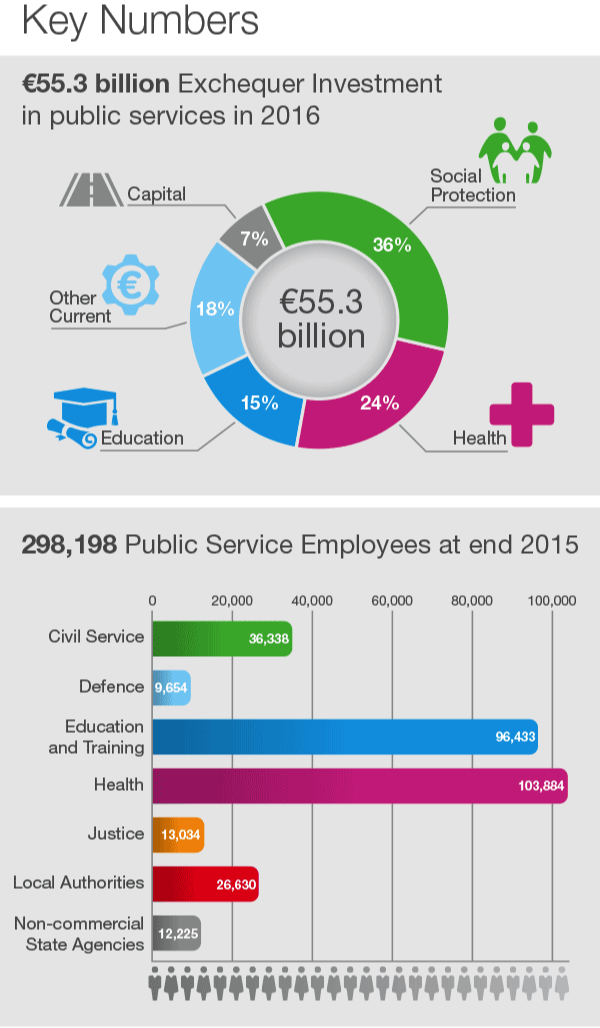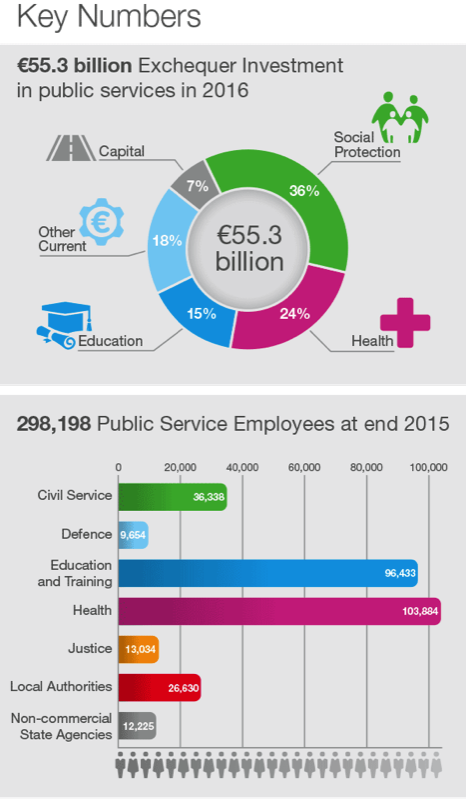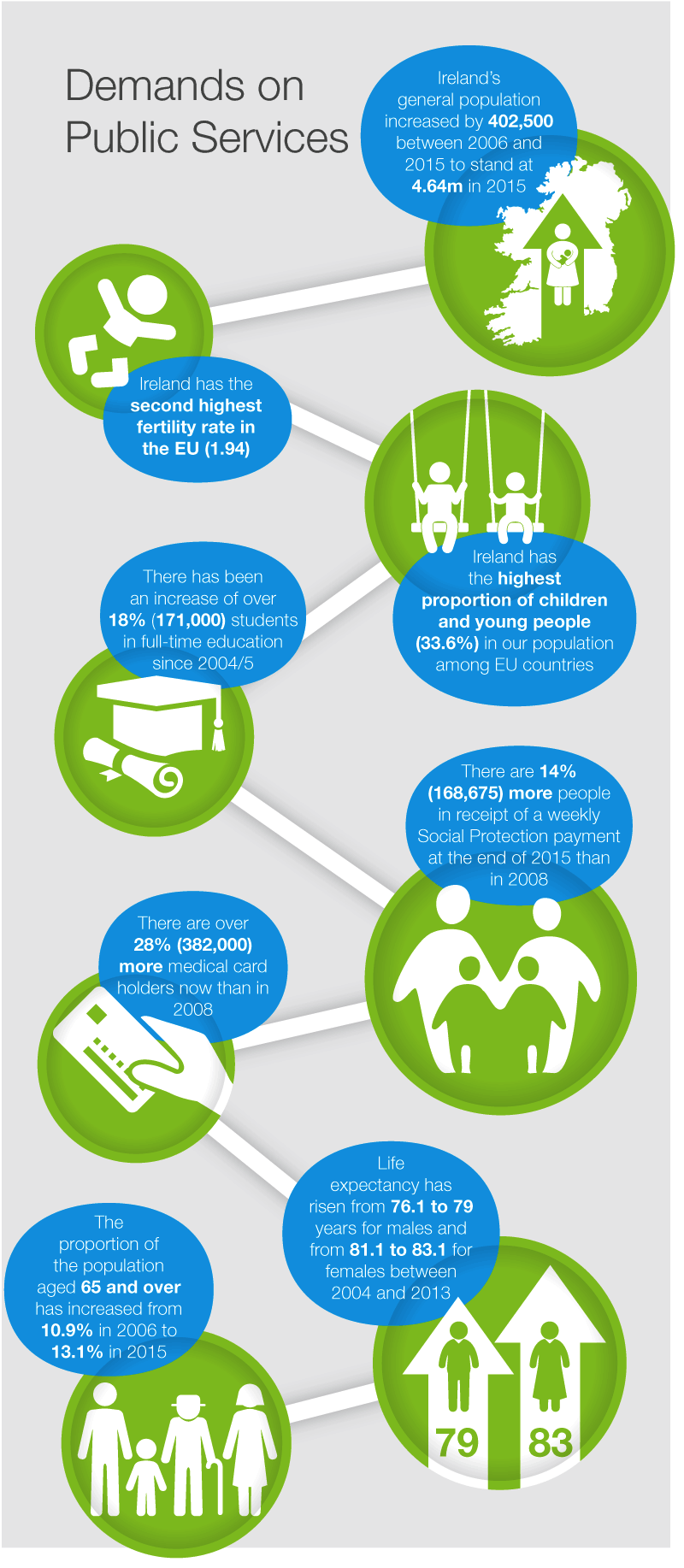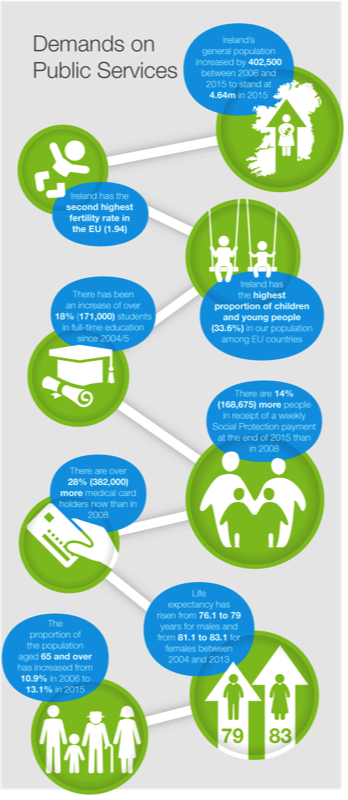Annual Progress Report on the Public Service Reform Plan 2014-2016
Executive Summary


Public Service Reform was a central element of the response to the crisis of recent years and remains an essential part of building for the future. Since the first Public Service Reform Plan was published in 2011, a comprehensive programme of reform has been implemented. This has enabled the Public Service to continue to provide essential services, while demand for those services increased and while resources were very constrained.
In 2015, there were around 298,000 public servants delivering many diverse services across hundreds of organisations. The “Public Service in Numbers” infographic on the preceding pages illustrates the breadth and volume of those services, using just some examples from each of the main sectors. The infographics opposite show the scale of investment in public services and the allocation of staff resources by sector.
The importance of an effective and efficient Public Service cannot be overstated. The performance of the Public Service has major implications for the management of the State’s finances and for employment creation. The quality of public services also affects how Ireland is perceived by businesses considering investing here. Most importantly, the Public Service provides essential services for our people when they need them most.
The IPA Public Sector Trends report 2015 shows Ireland’s public services performing above the European average in a number of comparative studies. For example, Ireland ranks fourth in the European Union for both the quality of its public administration and perceptions that Government decisions are implemented effectively. Ireland also does well for upholding traditional public service values, ranking sixth in the European Union. Indicators that assess the impact of public administration on the ability of companies to do business show that Irish public services are considered the least bureaucratic in Europe.
Public Service Reform since 2011
The first Public Service Reform Plan was published in November 2011. Fiscal adjustment was a key driver at that time and so the focus was, to a large extent, on cost containment and efficiency improvements. Public Service staff numbers were significantly reduced, while meeting increased demand for services due to the downturn. The reform of public services became critical to the delivery of those services and strong progress was made, as set out in two published progress reports.
The second Public Service Reform Plan was published in 2014 and reflects the need to maintain a focus on reducing costs and increasing efficiency, having regard to the continuing increased demands for many public services. However, the Plan has an ambitious, overarching objective of delivering better outcomes for all stakeholders and a strong emphasis on service improvement.
The infographic opposite illustrates the main demographic drivers of demand for public services. These include general population and life expectancy increases in the last ten years or so. It also illustrates how these drivers are reflected in increased demands for key services in a number of areas such as Health, Education and Social Protection. Overall, it is clear that there are current and future demographic trends that will continue to place growing demands on public service delivery.
The framework diagram in the Introduction illustrates how reforms in four key areas across all sectors of the Public Service are contributing to improved outcomes for citizens, businesses and public servants themselves.


- A Focus on Service Users
- A Focus on Efficiency
- A Focus on Openness, Transparency and Accountability
- A Focus on Leadership, Renewal and Organisational Reform
The first progress report on the 2014-16 Reform Plan was published in March 2015. As with that report, this second progress report is structured on the four key areas of reform listed above.
Main areas of progress on cross-cutting reform
In 2015, strong progress has continued in implementing the reforms set out in the Public Service Reform Plan 2014-16. Progress is set out in greater detail in the body of this report, with more than 170 specific examples included. Some highlights are as follows:
A Focus on Service Users
- The Public Service ICT Strategy, ‘Delivering better outcomes and efficiency through innovation and excellence in ICT’, was launched and the Office of the Government Chief Information Officer is leading its implementation, working with Departments and agencies across the Public Service;
- Over 1.9 million Public Services Cards have been issued to date, including over 630,000 Free Travel variants;
- The results of the Civil Service Customer Satisfaction Survey 2015 were published in May, with many positive findings;
- A public consultation on Commissioning Human, Social and Community Services has been undertaken, following an Open Policy Debate and a review of international evidence; and
- Benefacts.ie was launched with the aim of delivering greater public transparency on the work and funding of the non-profit sector in Ireland.
- Public servants have made a significant contribution to addressing the challenges that faced the economy and the public finances in recent years. The Exchequer pay bill was reduced by over 20% between 2009 and 2014 and staff numbers were also reduced by around 10% in that period;
- The Lansdowne Road Agreement was concluded in May 2015 and ratified by the ICTU Public Services Committee in September 2015, extending the Haddington Road Agreement until September 2018;
- The National Shared Services Office has been established within the Department of Public Expenditure and Reform to lead shared service strategy across the Civil Service and major shared services programmes are being rolled out;
- In the three years to the end of 2015, the Office of Government Procurement and its partner sector sourcing organisations in Health, Education, Local Government and Defence enabled procurement savings estimated as in excess of €160 million;
- The first progress report on the Government’s Property Asset Management Delivery Plan, ‘Accommodating Change – Measuring Success’, was published in July 2015 and sets out progress towards a more integrated approach to this key asset;
- A new Value for Money Review Programme for 2015-2017, covering over 40 areas of expenditure across all sectors, is now underway; and
- The Department of Finance and the Department of Public Expenditure and Reform jointly hosted a National Economic Dialogue in July 2015 as part of the new budgetary framework.
- The Open Data Governance Board was established in October 2015 and will lead and drive implementation of Open Data in Ireland;
- The General Scheme of a Bill on Data Sharing and Governance was approved by Government and legal drafting of the Bill is expected to commence shortly;
- The Freedom of Information Model Publication Scheme was published in October following public consultation;
- The Public Sector Standards Bill, 2015 was published in December;
- An Accountability Board for the Civil Service has been established; and
- A Corporate Governance Standard for the Civil Service was published in November.
- The Public Appointments Service ran over 150 open recruitment campaigns in 2015 for a range of diverse positions across the Public Service;
- In September, the first Civil Service wide employee engagement survey was carried out, with the results published in January 2016;
- Work is progressing to develop a new shared model for learning and development across the Civil Service;
- The first ever Civil Service Excellence and Innovation Awards were held in December; and
- Integrated Reform Delivery Plans for 2015 were completed by all Departments and major Offices early in 2015.
This report focuses primarily on cross-cutting reforms that generally apply right across the Public Service. The Reform Framework set out in the Introduction on page 9 illustrates the emphasis on driving reforms in the five key sectors of Health, Education, Local Government, Justice and the Civil Service.
In addition there are, of course, a range of further organisational or sector specific reforms, the implementation of which is led by the relevant Ministers and their Departments. Integrated Reform Delivery Plans (IRDPs) are produced annually by all Departments and major Offices to incorporate these specific reforms alongside the cross-cutting reforms from the Public Service Reform Plan, the Civil Service Renewal Plan and the Lansdowne Road Agreement.
Progress on the implementation of the 2015 IRDPs has contributed to this report, with a significant number of examples included from the many reform initiatives taking place across the Public Service.
Civil Service Renewal Plan
Published in October 2014, the Civil Service Renewal Plan is a significant part of the overall Public Service Reform Framework. The three year plan outlines 25 practical actions that will create a more unified, professional, responsive, open and accountable Civil Service that can provide a world-class service to the State and the people of Ireland.
In July 2015, the first progress report on the Civil Service Renewal Plan was published, detailing the significant progress in the ‘first 200 days’ of the Plan. It outlined how most actions had been initiated and confirmed that the Plan was on track to deliver transformational change in the sector.
Significant achievements in 2015 include the establishment of the Accountability Board; undertaking the Civil Service Staff Engagement Survey; the development of a Corporate Governance Standard for the Civil Service; designing and implementing a new performance review process for Secretaries General and enhancing the process for Assistant Secretaries; a programme of Townhall events to engage with staff around the country; the development of a new rating system for PMDS; strengthening the Disciplinary Code; and holding a series of Open Policy Debates involving stakeholders to support more open approaches to policy-making.
In addition, the inaugural Civil Service Excellence and Innovation Awards showcase was held in December highlighting achievements and innovations in policy and service delivery and recognising staff excellence. Details of the award winners are included in the Appendix and examples of winners and of shortlisted projects are referred to throughout this progress report.